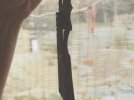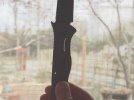I usually wait until the lock dictates that it needs adjustment before changing it or adjusting it. My dad's words here come to mind, 'if it ain't broke don't fix it.' Otherwise you may end up with a very sticky lock and actually increase the frequency of adjustments due to wear by forcing it along unecessarily. So, yeah, I'd say if the lock was new that it wasn't really needing anything done to it at this time. Unless I didn't get all the information and you did notice it needed attention I mean.
On your question about lock contact: The lock on a liner or frame lock should contact at two points as far from the midline of the pivot as the design will allow based on most interpretations of the correct lock make up. Those two points are the stop pin and the lock contact to form a 'tripod' for the blade to stabalize itself on, and of course that tripod is made up of the pivot in the center, the stop, at the top of the folder and lock contact at the bottom.
Now keeping in mind that there is a margin of tolerance or room for error as some would call it that is built into the design there are really no locks of this type being made that I've seen that contact 'fully'. Don't get me wrong they keep the blade from closing in most cases when you see one wearing in more spots along the lock than just the bottom third and they wear ok but lock contacts of the type that contact at some point on the bottom, middle and top in frame and liner locks allow what we call blade roll in most all cases. This is when you can put spine pressure on the blade and feel the blade move vertically or 'rock forward and back' but the lock doesn't defeat or give you problems otherwise. Rolling is movement of the blade and it comes from too much contact of the lock on the top portion of the lock or the middle which can both act to take away contact from the bottom third where it should be connecting and all it usually takes to remove the roll in the blade is to remove some lock contact from the top or middle so its no longer connecting to the blade and next thing you know its solid as it should be. Sometimes and old cutler trick called peening the lock contact by using a 3/32 flat end punch and a ball peen hammer can squish out just the right amount of contact at the bottom part of the lock so you can insure that the bottom is what is connecting more than the middle or top of the lock face and in these cases you can end up with what looks to be to the naked eye a 'full contact' but it usually is connecting more on the bottom as it should and wearing more there even if other spots do connect too so you still get a rock solid lock so long as the bottom third of the lock is what is contacting the blade providing its contacting far enough away from the midline of the pivot to keep the blade from still exhibiting that rolling movement. Peening is tricky and can lead to sticky locks too if you are not careful but again the lock is a critical part of the make up of the system anyway you cut it so messing with it unknowing can be disastrous if you are not careful. Truthfully its bad enough messing with them when you do know just enough to get you in trouble sometimes.

With that said, you have a margin of safe contact on the bottom third of the lock on the folder of this type and so long as the lock is contacting somewhere in that 'third' area its fine and will work great and lock up solid. Some come out of the factory or out of the mill by the maker whichever the case may be, with more contact distribution than others, or what I call a bigger contact foot print than others, even of the same model. For example, I've had models here for work made in the same year and in different years by the same company and the same knife all with various foot prints of lock contact but all had correctly done locks because they all locked up solid and were within tolerance. Personally it seems to me that Chris Reeves is the most consistent in this area and I mean consistent! He is as anal retentive about this as any I've seen and I say that as a positive because it is evidenced by the exemplary lock on his Sebenza folders.
On thinner liner locks I have to say that on examples where the locks contact is mostly at the very bottom of the possible area it can contact the blade and doesn't spread out a little more over that bottom third that it makes sense that they would indent easier than one that had a bigger foot print of contact due to the fact that the lock is thin and the contact is small but I think that this would be very hard to prove out since in many senses the thin liner locks begin self destruction from the moment they are used the first time and progress to self correct from that point on. Its the nature of the lock type.
There are several ways to adjust the locks from peening to pivot size increase to bumping up the stop pin to the next bigger diameter. Each method comes with consequences that must be dealt with based on what that will do to the system as a whole to change things and you have to be able to get those things you don't want changed back to where they were in the system while changing the lock when you do it by this method. Bumping up the stop pin for example, can refresh the lock on a folder that previously had a lock traveling all the way across the contact from wear but doing so can make the actual foot print of the lock contact smaller by increasing the gap between the blade and the lock at the top of the lock and at the same time mean you have to adjust the rest on the blade so the point of the blade is not sticking up out of the body when closed which it will do now since its no longer coming down as far by sitting on a bigger diameter pin than it did originally and also since the blade sits higher until you adjust it the blade won't be kept shut from gravity until the detent ball works again as it did before you made the change to the stop pin diameter.
Anyway, enough rambling. I'll leave it at that.
STR


